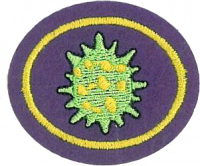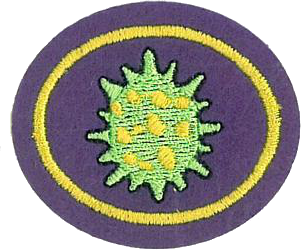Difference between revisions of "AY Honors/Viruses/Answer Key/es"
From Pathfinder Wiki
(Created page with "{{clear}}") |
(Updating to match new version of source page) |
||
| (39 intermediate revisions by 2 users not shown) | |||
| Line 1: | Line 1: | ||
| − | + | {{HonorSubpage}} | |
| − | + | <section begin="Body" /> | |
| − | |||
| − | {{ | ||
| − | |||
| − | |||
| − | |||
| − | |||
| − | |||
| − | |||
| − | |||
| − | |||
| − | |||
| − | |||
| − | |||
| − | |||
| − | <section begin="Body" /> | ||
{{ansreq|page={{#titleparts:{{PAGENAME}}|2|1}}|num=1}} | {{ansreq|page={{#titleparts:{{PAGENAME}}|2|1}}|num=1}} | ||
<noinclude></noinclude> | <noinclude></noinclude> | ||
| − | <!-- 1. | + | <!-- 1. Describir o discutir el siguiente con un grupo. Si es necesario, investigar posibles respuestas a estos temas para poder hacer contribuciones significativas al grupo. --> |
{{clear}} | {{clear}} | ||
| Line 30: | Line 15: | ||
{{clear}} | {{clear}} | ||
| − | {{clear}} | + | {{clear}} |
{{clear}} | {{clear}} | ||
| Line 49: | Line 34: | ||
{{clear}} | {{clear}} | ||
| − | {{clear}} | + | {{clear}} |
{{clear}} | {{clear}} | ||
| Line 89: | Line 74: | ||
<noinclude></noinclude> | <noinclude></noinclude> | ||
| − | {{clear}} | + | {{clear}} |
{{clear}} | {{clear}} | ||
| Line 162: | Line 147: | ||
{{clear}} | {{clear}} | ||
| − | {{clear}} | + | {{clear}} |
{{clear}} | {{clear}} | ||
| Line 185: | Line 170: | ||
{{clear}} | {{clear}} | ||
| − | {{clear}} | + | {{clear}} |
{{clear}} | {{clear}} | ||
| Line 206: | Line 191: | ||
{{ansreq|page={{#titleparts:{{PAGENAME}}|2|1}}|num=2}} | {{ansreq|page={{#titleparts:{{PAGENAME}}|2|1}}|num=2}} | ||
<noinclude></noinclude> | <noinclude></noinclude> | ||
| − | <!-- 2. | + | <!-- 2. Por medio de imágenes, video o descripciones detalladas, explicar las diferencias de las siguientes enfermedades exantemáticas o eruptivas: --> |
<noinclude></noinclude> | <noinclude></noinclude> | ||
| Line 250: | Line 235: | ||
{{clear}} | {{clear}} | ||
| − | + | {{clear}} | |
| − | + | {{clear}} | |
| − | + | {{clear}} | |
| − | + | {{clear}} | |
| − | |||
| − | |||
| − | |||
| − | |||
| − | + | {{clear}} | |
| − | |||
<noinclude></noinclude> | <noinclude></noinclude> | ||
| Line 270: | Line 250: | ||
{{ansreq|page={{#titleparts:{{PAGENAME}}|2|1}}|num=3}} | {{ansreq|page={{#titleparts:{{PAGENAME}}|2|1}}|num=3}} | ||
<noinclude></noinclude> | <noinclude></noinclude> | ||
| − | <!-- 3. | + | <!-- 3. Escoger tres de las siguientes enfermedades virales y describir la forma de contagio, síntomas y prevención. Demostrar su aprendizaje de manera creativa por medio de una exhibición, presentación o discurso preparado: --> |
| − | + | {{clear}} | |
<noinclude></noinclude> | <noinclude></noinclude> | ||
{{ansreq|page={{#titleparts:{{PAGENAME}}|2|1}}|num=3a}} <!--T:60--> | {{ansreq|page={{#titleparts:{{PAGENAME}}|2|1}}|num=3a}} <!--T:60--> | ||
<noinclude></noinclude> | <noinclude></noinclude> | ||
| − | |||
| − | |||
| − | |||
| − | |||
<noinclude></noinclude> | <noinclude></noinclude> | ||
| Line 286: | Line 262: | ||
{{ansreq|page={{#titleparts:{{PAGENAME}}|2|1}}|num=3b}} <!--T:61--> | {{ansreq|page={{#titleparts:{{PAGENAME}}|2|1}}|num=3b}} <!--T:61--> | ||
<noinclude></noinclude> | <noinclude></noinclude> | ||
| − | |||
| − | |||
| − | |||
| − | |||
| − | |||
<noinclude></noinclude> | <noinclude></noinclude> | ||
{{CloseReq}} <!-- 3b --> | {{CloseReq}} <!-- 3b --> | ||
| − | {{ansreq|page={{#titleparts:{{PAGENAME}}|2|1}}|num=3c}} <!--T: | + | |
| + | {{ansreq|page={{#titleparts:{{PAGENAME}}|2|1}}|num=3c}} <!--T:61--> | ||
<noinclude></noinclude> | <noinclude></noinclude> | ||
| − | |||
| − | |||
<noinclude></noinclude> | <noinclude></noinclude> | ||
{{CloseReq}} <!-- 3c --> | {{CloseReq}} <!-- 3c --> | ||
| − | {{ansreq|page={{#titleparts:{{PAGENAME}}|2|1}}|num=3d}} <!--T: | + | |
| + | {{ansreq|page={{#titleparts:{{PAGENAME}}|2|1}}|num=3d}} <!--T:61--> | ||
<noinclude></noinclude> | <noinclude></noinclude> | ||
| − | |||
| − | |||
<noinclude></noinclude> | <noinclude></noinclude> | ||
{{CloseReq}} <!-- 3d --> | {{CloseReq}} <!-- 3d --> | ||
| − | {{ansreq|page={{#titleparts:{{PAGENAME}}|2|1}}|num=3e}} <!--T: | + | |
| + | {{ansreq|page={{#titleparts:{{PAGENAME}}|2|1}}|num=3e}} <!--T:61--> | ||
<noinclude></noinclude> | <noinclude></noinclude> | ||
| − | |||
| − | |||
<noinclude></noinclude> | <noinclude></noinclude> | ||
{{CloseReq}} <!-- 3e --> | {{CloseReq}} <!-- 3e --> | ||
| − | {{ansreq|page={{#titleparts:{{PAGENAME}}|2|1}}|num=3f}} <!--T: | + | |
| − | <noinclude></noinclude> | + | {{ansreq|page={{#titleparts:{{PAGENAME}}|2|1}}|num=3f}} <!--T:61--> |
| − | + | <noinclude></noinclude> | |
<noinclude></noinclude> | <noinclude></noinclude> | ||
{{CloseReq}} <!-- 3f --> | {{CloseReq}} <!-- 3f --> | ||
| − | {{ansreq|page={{#titleparts:{{PAGENAME}}|2|1}}|num=3g}} <!--T: | + | {{ansreq|page={{#titleparts:{{PAGENAME}}|2|1}}|num=3g}} <!--T:62--> |
<noinclude></noinclude> | <noinclude></noinclude> | ||
| − | |||
<noinclude></noinclude> | <noinclude></noinclude> | ||
{{CloseReq}} <!-- 3g --> | {{CloseReq}} <!-- 3g --> | ||
| − | {{ansreq|page={{#titleparts:{{PAGENAME}}|2|1}}|num=3h}} <!--T:67--> | + | {{ansreq|page={{#titleparts:{{PAGENAME}}|2|1}}|num=3h}} <!--T:63--> |
| + | <noinclude></noinclude> | ||
| + | |||
| + | <noinclude></noinclude> | ||
| + | {{CloseReq}} <!-- 3h --> | ||
| + | {{ansreq|page={{#titleparts:{{PAGENAME}}|2|1}}|num=3i}} <!--T:64--> | ||
| + | <noinclude></noinclude> | ||
| + | |||
| + | <noinclude></noinclude> | ||
| + | {{CloseReq}} <!-- 3i --> | ||
| + | {{ansreq|page={{#titleparts:{{PAGENAME}}|2|1}}|num=3j}} <!--T:65--> | ||
| + | <noinclude></noinclude> | ||
| + | |||
| + | <noinclude></noinclude> | ||
| + | {{CloseReq}} <!-- 3j --> | ||
| + | {{ansreq|page={{#titleparts:{{PAGENAME}}|2|1}}|num=3k}} <!--T:66--> | ||
| + | <noinclude></noinclude> | ||
| + | |||
| + | <noinclude></noinclude> | ||
| + | {{CloseReq}} <!-- 3k --> | ||
| + | {{ansreq|page={{#titleparts:{{PAGENAME}}|2|1}}|num=3l}} <!--T:67--> | ||
<noinclude></noinclude> | <noinclude></noinclude> | ||
| − | + | {{clear}} | |
<noinclude></noinclude> | <noinclude></noinclude> | ||
| − | {{CloseReq}} <!-- | + | {{CloseReq}} <!-- 3l --> |
{{CloseReq}} <!-- 3 --> | {{CloseReq}} <!-- 3 --> | ||
{{ansreq|page={{#titleparts:{{PAGENAME}}|2|1}}|num=4}} | {{ansreq|page={{#titleparts:{{PAGENAME}}|2|1}}|num=4}} | ||
<noinclude></noinclude> | <noinclude></noinclude> | ||
| − | <!-- 4. | + | <!-- 4. Explicar las diferencias entre la gripe y el resfriado. ¿Por qué el virus de la influenza causa epidemias periódicas (como la gripe española, gripe aviar, gripe A, etc.)? --> |
| − | + | {{clear}} | |
| − | + | {{clear}} | |
| − | + | {{clear}} | |
| − | + | {{clear}} | |
<noinclude></noinclude> | <noinclude></noinclude> | ||
| Line 347: | Line 334: | ||
{{ansreq|page={{#titleparts:{{PAGENAME}}|2|1}}|num=5}} | {{ansreq|page={{#titleparts:{{PAGENAME}}|2|1}}|num=5}} | ||
<noinclude></noinclude> | <noinclude></noinclude> | ||
| − | <!-- 5. | + | <!-- 5. ¿Cuál es la diferencia entre un virus y prion? Nombrar una enfermedad causada por un prion. --> |
| − | + | {{clear}} | |
| − | + | {{clear}} | |
| − | + | {{clear}} | |
<noinclude></noinclude> | <noinclude></noinclude> | ||
| Line 359: | Line 346: | ||
{{ansreq|page={{#titleparts:{{PAGENAME}}|2|1}}|num=6}} | {{ansreq|page={{#titleparts:{{PAGENAME}}|2|1}}|num=6}} | ||
<noinclude></noinclude> | <noinclude></noinclude> | ||
| − | <!-- 6. | + | <!-- 6. Hacer una de las siguientes: --> |
<noinclude></noinclude> | <noinclude></noinclude> | ||
| Line 365: | Line 352: | ||
<noinclude></noinclude> | <noinclude></noinclude> | ||
| − | + | {{clear}} | |
| − | + | {{clear}} | |
| − | |||
| − | |||
| − | |||
| − | |||
| − | |||
| − | |||
<noinclude></noinclude> | <noinclude></noinclude> | ||
| Line 400: | Line 381: | ||
<noinclude></noinclude> | <noinclude></noinclude> | ||
==Referencias== | ==Referencias== | ||
| − | |||
| − | |||
| − | |||
<noinclude></noinclude> | <noinclude></noinclude> | ||
| − | + | [[Category:Adventist Youth Honors Answer Book/Do at home{{GetLangSuffix}}]] | |
| + | {{CloseHonorPage}} | ||
Latest revision as of 15:19, 3 January 2023
1
Describir o discutir el siguiente con un grupo. Si es necesario, investigar posibles respuestas a estos temas para poder hacer contribuciones significativas al grupo.
1a
¿Qué significa la palabra virus? Explicar la controversia sobre si se trata de un ser vivo o no.
1b
Nombrar las características distintivas de los virus y por qué no están incluidos en ningún reino.
1c
Nombrar algunas formas morfológicas de los virus y dar un ejemplo de cada una.
1d
Explicar la importancia de las vacunas para combatir los virus. ¿Cómo funcionan?
1e
Describir cómo los virus reproducen y cómo ocurren las modificaciones genéticas llamadas mutaciones y la resistencia viral.
1f
¿Se han erradicado enfermedades virales? ¿Por qué es tan difícil tratar a los pacientes con enfermedades virales?
2
Por medio de imágenes, video o descripciones detalladas, explicar las diferencias de las siguientes enfermedades exantemáticas o eruptivas:
2a
Rubéola
2b
Sarampión
2c
Varicela
3
Escoger tres de las siguientes enfermedades virales y describir la forma de contagio, síntomas y prevención. Demostrar su aprendizaje de manera creativa por medio de una exhibición, presentación o discurso preparado:
3a
COVID-19
3b
Zika
3c
Ébola
3d
Nilo Occidental
3e
Mano-pie-boca (aftosa humana)
3f
Herpes
3g
SIDA
3h
Papera
3i
Poliomielitis
3j
Meningitis
3k
Hepatitis
3l
Dengue
4
Explicar las diferencias entre la gripe y el resfriado. ¿Por qué el virus de la influenza causa epidemias periódicas (como la gripe española, gripe aviar, gripe A, etc.)?
5
¿Cuál es la diferencia entre un virus y prion? Nombrar una enfermedad causada por un prion.
6
Hacer una de las siguientes:
6a
Dar un breve informe acerca de una pandemia viral y el impacto que causó/está causando en el mundo.
6b
Crear un drama, presentación multimedia u otra exhibición interactiva que informa a una audiencia del peligro de uno o más de estos virus y les da capacitación acerca de cómo combatir o controlar el virus.
6c
Tener un trabajador de ayuda humanitaria dar una charla o presentación acerca de epidemias y control de virus en los países que haya servido. Recaudar dinero como un grupo para apoyar a la ayuda humanitaria al país de que le informa el trabajador.


